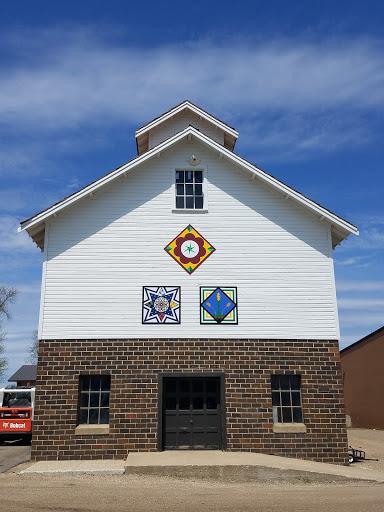
- Location: Seed House, Alumni Drive (adjacent to North Parking Lot)
- Installed: May 2019
- Artist(s): Students in Professor of Art HistoryJulia Dabbs' first-year Intellectual Community course, "Art + History, UMM + Community," fall 2018
Background on the artworks
Barn quilts are a growing rural art phenomenon in which quilt block designs (traditional or original) are painted onto plywood and hung permanetly on an exterior surface, whether a barn, house, or other building. They not only add color to the rural landscape, but also express something symbolic about the owner's identity, interests, or heritage.
In fall 2018 UMN Morris was invited to participate in the Stevens County Barn Quilt trail, given the campu's history and students as well as the presence of barns on campus. Dabbs decided to build a course around this project, and three barn quilts resulted as group projects by the first-year students in her "Art + History, UMM + Community" course. These bold designs, clustered together on the Seed House façade to show their relationships to one another, visually express our three campus identities.
"Native American Heritage Barn Quilt" (lower left)
This quilt was created to acknowledge the presence of the American Indian Boarding School on the Morris campus site from 1887-1909 and to honor American Indian students, staff, and faculty at UMN Morris today. Traditional design motifs from Lakota, Dakota, and Anishnaabe cultures (such as the eight-pointed star of the Star quilt, the four directions of the Medicine Wheel, and the dream catcher) have been synthesized here to form an original, meaningful work of art.
"Agriculture Barn Quilt" (lower right)
This quilt honors the presence of the West Central School of Agriculture, which was housed on this campus from 1910-63, as well as the deep roots of agriculture in Stevens County. Two crops that historically were especially important in this area, namely corn and wheat, are given prominence in the design. Those forms are surrounded by gold and green squares, respresenting acres of land.
"UMN Morris Barn Quilt"(upper)
This quilt symbolically recognizes three identities of our campus to date, and presumably into the future—our liberal arts tradition, represented by the seven-petal floral form (an idea derived from medieval symbolism); our green campus initiatives, shown by the pinwheeling turbine blades, here literally turned green; and the pervasive maroon and gold colors, symbolizing our place within the University of Minnesota System. The four green diamond shapes at the corners reiterate our current emphasis on sustainability and represent the four academic divisions on our campus (Education, Humanities, Science/Mathematics, and Social Science). This barn quilt is hung "on point" above and between the other two foundational barn quilts so that it will be "similar to a guiding star, allowing a glimpse into the present, as well as the future."